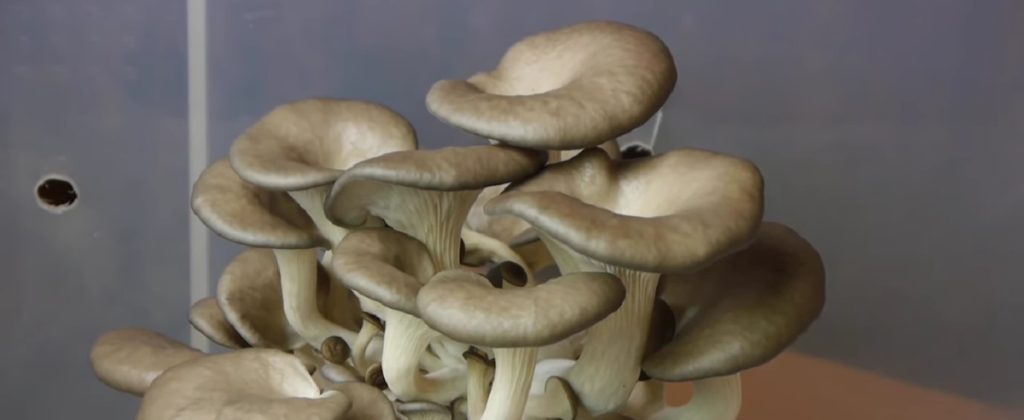In the wild, fungi need specific weather conditions to produce mushrooms and can remain dormant for long periods waiting for the right conditions to fruit.
To grow mushrooms at home, you need to replicate these conditions and trigger fruiting, but this is not always easy.
One of the biggest challenges for many indoor mushroom cultivators is maintaining high levels of humidity while at the same time allowing enough fresh air exchange to create the ideal environment for their mushrooms.
Addressing this is where fruiting chambers come in. A shotgun fruiting chamber is a fantastic way for beginner mushroom growers to get started.
In this article, you’ll discover what a shotgun fruiting chamber is, how it works, what you need to build one and how to build and use a shotgun fruiting chamber.
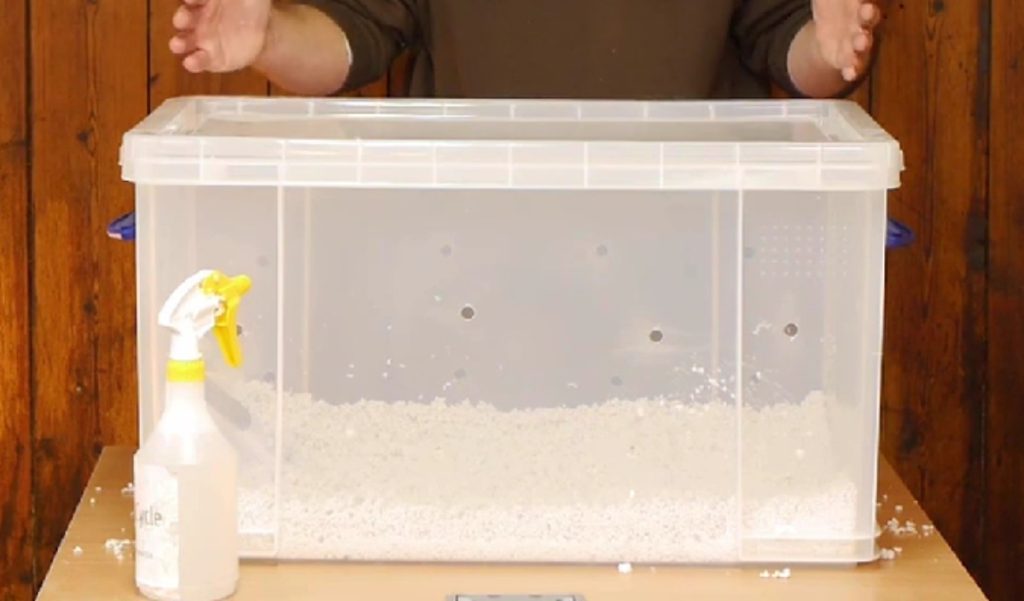
What is a Shotgun Fruiting Chamber?
A shotgun fruiting chamber, or SGFC for short, is an easy-to-build, low-maintenance mushroom fruiting chamber.
It consists of a large clear plastic container with holes drilled on all sides, including the top and bottom, and a 2 to 4 inch (5 to 10 cm) layer of damp perlite at the bottom.
The shotgun fruiting chamber gets its name from the scattered pattern of ventilation holes that reminds people of shotgun bullet holes.
It’s ideal for new growers working with PF Tek cakes or mushrooms that grow in bags, like oyster, reishi, lion’s mane, chestnut or shiitake mushrooms.
For those wondering what a PF Tek cake is, it’s a block of colonized substrate created using PF Tek or the Psilocybe fanaticus technique.
This technique is suitable for many species of mushrooms, uses commonly available materials and makes growing mushrooms at home easier for beginners.
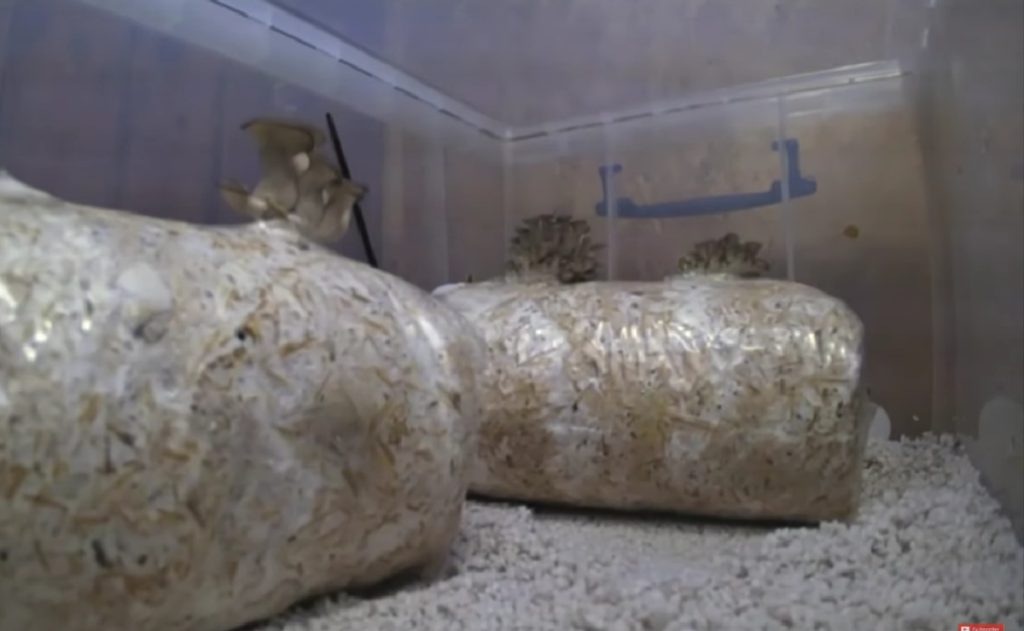
Do You Need a Fruiting Chamber?
No you don’t always need a fruiting chamber to grow mushrooms, and your local climate is one of the deciding factors.
In areas with the right temperatures and humidity, you can grow mushrooms without fruiting chambers on kitchen counters, outdoors on logs and in mushroom beds or greenhouses.
But, in areas with extreme temperatures it’s not so easy. To stimulate fruiting and grow healthy mushrooms, you need to create fruiting conditions.
One of the most challenging aspects for many growers is achieving the right balance between fresh air exchange and humidity.
A fruiting chamber makes maintaining this balance easier, and mushrooms in fruiting chambers need less monitoring and input.
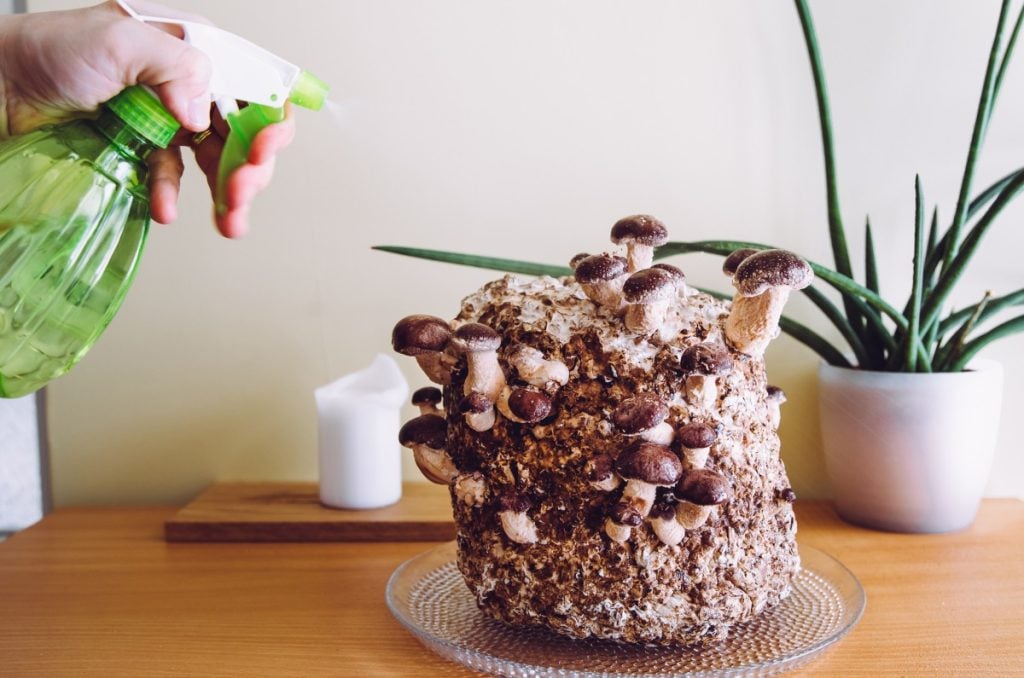
What Triggers Mushroom Fruiting?
In the wild, mushrooms fruit when weather conditions are ideal for mushroom growth and important factors are temperature, humidity, light and fresh air.
In your fruiting chamber, you aim to mimic these natural conditions and signal to the fungal mycelium growing in your mushroom substrate that it’s time to fruit.
What Temperature Should a Fruiting Chamber be?
Mushroom fruiting chamber temperatures vary depending on the mushroom species you’re growing.
But, keeping temperatures between 60 and 65°F (15.5 and 18°C) in your fruiting chamber is a safe range.
Although some types of summer oyster mushrooms, like phoenix oysters, prefer warmer temperatures, most mushrooms enjoy cooler autumn temperatures.

How Wet Should a Fruiting Chamber be?
Humidity is an important factor for mushroom growth, and depending on the growth stage of your mushrooms, you’ll need humidity levels of 75% to 90% in your fruiting chamber.
For mycelium to start pinning, you need relative humidity levels of around 90%, and for later growth stages, aim to keep humidity levels above 80%.
Do You Need Light in a Fruiting Chamber?
Although fungi don’t need light to produce food like plants, they need indirect light to grow. When kept in the dark, they will not fruit.
In nature, sunlight would indicate to the underground fungus that it has reached the outside or surface of its substrate and can start fruiting.
This information is crucial for the fungus as they need to produce mushrooms outside the substrate to reproduce and spread to new locations.
Why Do You Need Fresh Air Exchange in a Fruiting Chamber?
As fungi grow, they consume oxygen and produce CO2, and if the CO2 levels inside your fruiting chamber get too high, it affects the mushroom’s growth.
In nature, mushrooms grow out the ground or decaying logs into oxygen-rich fresh air.
Fungal mycelium tolerates, and sometimes even needs, higher levels of CO2 while colonizing a substrate, and exposing it to fresh air helps to trigger fruiting.
Providing fresh air and lowering the levels of CO2 mimics natural conditions, because, in nature, when the mycelium reaches the surface, there is more fresh air than underground.

How Does a Shotgun Fruiting Chamber Work?
When set up correctly, a properly made shotgun fruiting chamber uses natural air currents to maintain humidity and provide constant fresh air exchange.
Fresh air enters the chamber through the holes in the bottom of the container. It then rises through the damp perlite, causing the water in the perlite to evaporate and increase the humidity.
Warm air rises and the heat generated by the growing mycelium is enough to pull the humid air up through the perlite.
The warm, humid air then flows up and out the holes at the top of the container, allowing more fresh air to enter from the bottom.
The shotgun fruiting chamber design allows constant fresh air transfer without lowering the humidity.
Monotub vs Shotgun Fruiting Chamber
A monotub and a shotgun fruiting chamber are both easy to make and very similar in appearance as they both use a see-through bin or tote, but you use them very differently.
Here are some of the differences:
- Size of holes – Shotgun fruiting chambers have lots of small 0.25 inch (0.6 cm) holes on all 6 sides, including the top and bottom, whereas monotubs only have a few 2-inch (5 cm) sized holes on the sides.
- Surrounding airflow – A SGFC needs a location without competing airflow for the natural currents to work. But a monotub benefits from having a fan in the room. Although not aimed directly at the tub.
- Method of use – When using monotubs, you add the grain spawn and substrate directly to the monotub and incubation and fruiting both take place in the monotub.
When using a SGFC, you place fully colonized PF Tek cakes or grow bags in the chamber for fruiting.
- Hole covering – There’s no covering on shotgun fruiting chamber holes, but monotub holes are completely covered during the incubation phase and have filter of some kind applied during fruiting.
- Use of perlite – A SGFC uses damp perlite at the bottom of the bin to maintain high humidity levels while a monotub does not. People often use a monotub with a bulk substrate that contains vermiculite to help hold moisture.
Materials Needed to Build a Shotgun Fruiting Chamber
Once you have the materials, you can build a shotgun fruiting chamber in less than an hour and only need a few everyday tools.
Materials Needed
- A clear plastic tote with a lid – A tote around 70 quarts (66 liters) in size works well for 2 substrate blocks or grow kits.
Your tote needs to be tall enough for 2 to 4 inches (5 to 10 cm) of perlite and 5 to 10 inches (12 to 25cm) of space for fruiting blocks and growth.
Very large totes may result in uneven air circulation, and small totes are not big enough to create their own circulation system.
- 10 to 12 quarts (9.5 to 11.5 liters) coarse perlite – Perlite is lightweight material created by heating volcanic glass to extremely high temperatures.
Perlite is commonly used as a soil amendment by gardeners to help soils retain water better. You can find perlite at most garden stores.
- A spray bottle
- Something to elevate the SGFC
- Hygrometer (optional)
- Artificial lighting (optional)
Tools Needed
- A Power Drill with a ¼-inch bit
- A measuring tape or ruler
- A permanent marker
How to Make a Shotgun Fruiting Chamber Step by Step
Follow the steps below to make a shotgun fruiting chamber.
Step 1: Measure and Mark Hole Locations
Using a measuring tape or ruler and the permanent marker, measure and mark the locations for the holes.
To get proper airflow through the chamber, you need evenly spaced holes on all sides of your tote, including the bottom and the lid.
Growers generally agree that a grid of holes spaced 2 inches (5 cm) apart gives the best results.
Step 2: Drill Holes
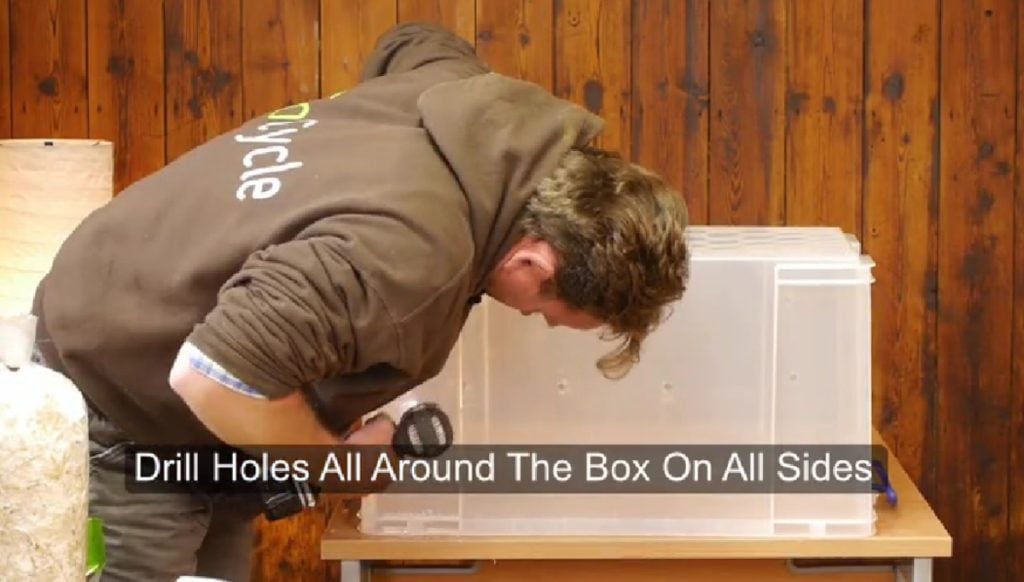
Once you have marked all the holes locations, it’s time to start drilling.
Using a ¼-inch drill bit, carefully drill holes on your marks, making sure not to press too hard and crack the plastic.
Running the drill at higher speed and drilling slowly while applying minimal pressure helps prevent cracks.
When you finish drilling, scrape off any shards or dangling pieces stuck on the edge of the holes, then wash and dry the bin.
Step 3: Add The Perlite

Cover the bottom of the tote with 2 to 4 inches (5 to 10 cm) of coarse perlite. The exact depth of the layer is not an issue.
You’ll need enough to cover the bottom of the tote evenly with a few inches of perlite. But must still have at least 5 inches (12 cm) of open space above the perlite to allow for proper air circulation.
When you add and mix the perlite, a little may fall through the holes but should soon stop.
To help prevent this, use the coarsest perlite you can find. Finely ground perlite will fall through the holes and does not hold as much water as coarse perlite.
Coarse perlite is full of tiny air compartments, nooks and crannies that capture and hold water.
When you have your layer of perlite in the bin, pour water over it, mixing it with your hand or a wooden spoon to evenly distribute the water.
Use just enough water to moisten the perlite. You don’t need to soak it to the point that water is pouring out the holes in the bottom of your tote.
The aim is to moisten and coat the perlite with water that will evaporate slowly and increase the humidity levels in the tote.

Can You Use Vermiculite in a Shotgun Fruiting Chamber?
Vermiculite is often used in mushroom substrate recipes and in monotubs, but it would not be a good option for use in the bottom of a shotgun fruiting chamber.
Although both products are similar, vermiculite holds water and contains nutrients, while perlite provides a large surface area for water evaporation and has no nutritional value.
These properties mean that while vermiculite holds more water than perlite, it would not release as much water into the chamber, and its nutrients increase the chances of contamination.
Vermiculite is also heavier than perlite and more likely to compact. Thus it’s harder for air to flow through vermiculite and increase the humidity levels.
Step 4: Find a Suitable Location For Your Shotgun Fruiting Chamber
Consider lighting, airflow, and temperature when deciding where to put your shotgun fruiting chamber.
A space near a window with indirect natural light away from drafts is the best spot for a SGFC.
Direct sunlight will dry out the mushrooms and may heat the fruiting chamber to intolerable levels.
If natural light is not an option, you can simulate natural light with a small fluorescent or LED light and a timer.
Set the light to be on for 12 hours a day, and if using a fluorescent globe, make sure it is not close enough to overheat the fruiting chamber.
Tip: If you can see inside the shotgun fruiting chamber, there’s enough light for the mushrooms to fruit.
Your fruiting chamber needs airflow but not an excessively drafty space. Running a fan near your shotgun fruiting chamber will dry everything out and disrupt the natural air currents in the tote.
Fruiting temperature requirements vary from species to species, but many easy-to-grow mushroom species do well at room temperature.
Step 5: Elevate Your Shotgun Fruiting Chamber
For the natural currents in your shotgun fruiting chamber to work, it should not sit directly on a flat surface.
You’ll need to elevate it slightly using a stand or legs of some sort.
While many totes have feet that slightly elevate the base, growers suggest raising your SGFC a minimum of 2 inches (5 cm).
You can use whatever you have available to make legs but make sure they’re sturdy and stable, and won’t fall over.
People suggest using wide-mouth jars, shot glasses, soup cans, large toy blocks or pieces of PVC pipe cut to size.
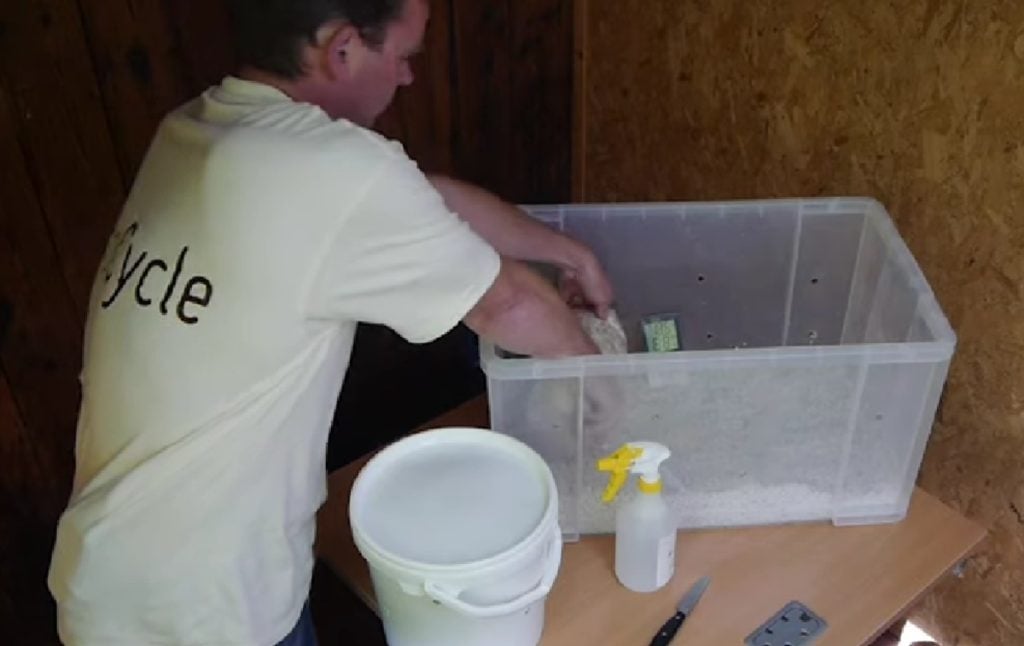
How to Use a Shotgun Fruiting Chamber
Now that your shotgun fruiting chamber is ready to use, place your PF Tek cakes, mushroom growing bags or kits inside.
When placing PF Tek cakes into the chamber, put them on pieces of foil so they’re not in direct contact with the perlite.
It’s tempting to place lots of cakes, bags or blocks in your chamber together.
But the point of the shotgun fruiting chamber design is to provide plenty of airflow around the cakes or blocks, and overfilling the chamber will hinder this.
A shotgun fruiting chamber is not maintenance-free and requires fanning and spraying at least twice daily.
Even though a SGFC has holes for air exchange, they’re not enough, and you’ll need to take off the lid and lightly fan the mushrooms. Fanning replaces the stale air at the bottom of the tote with fresh oxygen-rich air.
After each fanning, you’ll need to mist the sides of the tote and perlite with a spray bottle to keep the humidity levels up. Avoid spraying the substrate blocks and actual mushrooms as much as possible, as water droplets on these can cause mold.
As humidity is so important when growing mushrooms, a hygrometer is a useful tool that helps you know when moisture is needed. It also allows you to adjust the moisture levels for the different stages of the mushroom’s growth.
You can choose from several models, but not all of them have a range that can measure the high levels of humidity required for mushroom growing. Ensure you buy a hygrometer that can measure up to at least 90% relative humidity.
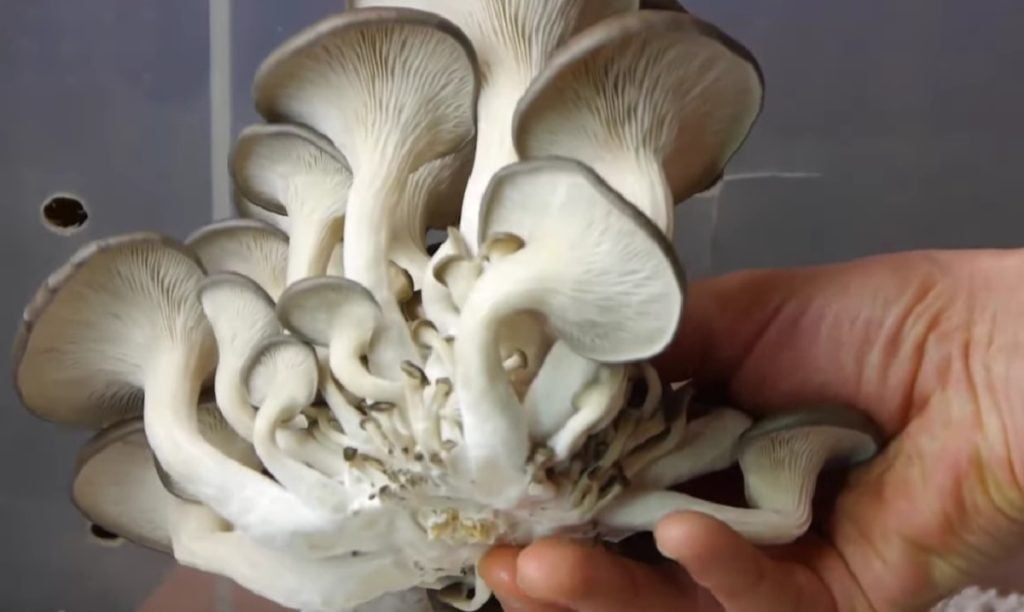
Pros And Cons of Using a Shotgun Fruiting Chamber
Like other fruiting chambers, shotgun fruiting chambers have pros and cons, and depending on your requirements may not be the best option for you.
To help you decide, here are some SGFC pros and cons:
Pros
- Quick, easy and inexpensive to build
- Works for grow bags, substrate cakes and blocks
- Allows you to use natural light to grow your mushrooms
- Creates a humid environment while still allowing fresh air exchange
- You can leave it unattended for up to 14 hours
- You can clean and reuse the perlite
- You can add additional equipment like humidifiers and lighting
Cons
- Limited size only allows small-scale mushroom growing
- Requires daily monitoring and maintenance
- Requires a space with the correct temperature and no drafts

Common Issues + How to Troubleshoot Them
Here are some of the common issues experienced and how to address them:
1. Withered or Cracked Mushrooms
Cracked, shriveled mushrooms indicate that your humidity levels are too low. To address this, mist the perlite and container more frequently.
Also, ensure you elevate your container enough to allow air to flow through the perlite and facilitate evaporation.
2. No Mushrooms Forming
Several things may cause this, but commonly incorrect humidity or not enough airflow is to blame.
Use a hygrometer to track and adjust humidity levels. To increase airflow, add more holes to your tote or leave the lid off for short periods throughout the day.
3. Pale Mushrooms
Pale mushrooms may signal your mushrooms are not getting enough light, or perhaps the temperature is too high.
If using natural lighting, you may need to add some LED lights or increase the time the lights are on.
Use a thermometer to check the temperature inside the chamber and, if necessary, move it to a better location.
Final Thoughts
Shotgun fruiting chambers are easy to build, inexpensive, and low maintenance, making them the perfect starting point for beginner mushroom growers.
You can build a SGFC in less than an hour using everyday household tools, and if you have a spray bottle handy, you only need to buy a clear plastic tote and perlite.
You can use shotgun fruiting chambers to fruit several kinds of colonized substrate, including PF Tek cakes, grow bags, bulk substrate blocks, and grain spawn.
But, a shotgun fruiting chamber is not very big and mushroom growers who want to grow more mushrooms should consider building a martha grow tent or hydroponic grow tent as they provide a lot more space.
To learn more about mushroom growing, visit our Mushroom Growing Hub or enroll in one of our online mushroom cultivation courses.
